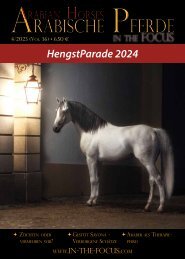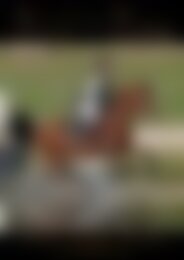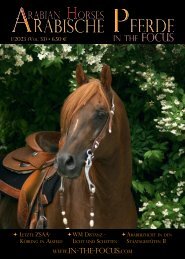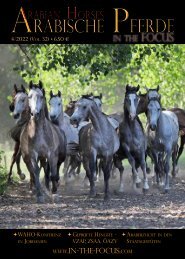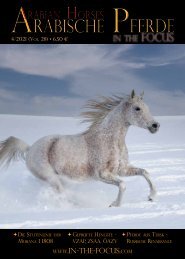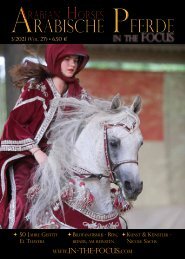Sie wollen auch ein ePaper? Erhöhen Sie die Reichweite Ihrer Titel.
YUMPU macht aus Druck-PDFs automatisch weboptimierte ePaper, die Google liebt.
Rennpferde über kurze Distanzen brauchen ein anderes Muskeltraining<br />
als ein Distanzpferd. - Racehorses running over short distances (Sprinter)<br />
need to have a different power training than endurance horses.<br />
Die Geschwindigkeit, während derer diese Anstrengung erreicht wird,<br />
kann erhöht werden, aber hohe Geschwindigkeit ist noch nicht wünschenswert.<br />
Bevor wir auf hohe Geschwindigkeit umsteigen, müssen<br />
wir die Fähigkeit entwickeln, genug Treibstoff zu speichern, den wir<br />
beim Einsatz von anaerober Energie benötigen.<br />
Der Verlauf dieser Phase des Outdoor-Trainings ist beispielsweise:<br />
1) langsam + flach + lang (was wir in der Anfangsphase getan haben)<br />
2) langsam + Steigung<br />
3) langsam + Steigung + lang<br />
4) Trab + flach + lang<br />
5) Trab + Steigung<br />
6) Trab + Steigung + lang<br />
7) langsamer Galopp + flach<br />
Zu diesem Outdoor-Training kann (abhängig ob verfügbar oder<br />
nicht) nach und nach hinzugefügt werden:<br />
• Training (Laufen) im Wasser (Meer oder Fluss): immer tiefer und /<br />
oder gegen den Strom gehen<br />
• Training (Laufen) in tiefen Sand (Dünen oder trockener Strand) zunehmend<br />
länger und bergauf<br />
Das Training spezifischer Muskeln<br />
B. Das Training spezifischer Muskeln entsprechend den Bedürfnissen<br />
jedes <strong>Pferde</strong>s (hier muß man sich den Schwächen des <strong>Pferde</strong>s<br />
bewusst sein!) kann im Freilauf, an der Longe oder unter dem Sattel<br />
erfolgen (letzteres mit Vorsicht!).<br />
Ein paar Beispiele:<br />
1) Cavaletti: Indem man das Pferd über etwas erhöhte Cavalettis<br />
traben läßt, kann man es ermutigen, seine Beine höher zu heben<br />
und so die Muskeln der Schulter, Ober- und Unterarme sowie die<br />
Muskeln der Kruppe und der Hinterbeine zu stärken. Die Cavalettis<br />
können zu Beginn im Abstand von drei Schritten sein, um bald darauf<br />
zwei Schritte auseinander und schließlich nur einen Schritt auseinander<br />
zu stehen. Die Höhe kann auch progressiv erhöht werden<br />
(auch asymmetrisch), indem man die Stange in den verschiedenen<br />
Winkeln des Kreuzes setzt, womit man drei verschiedene Höhen erreicht.<br />
2) Durch das Longieren mit einem "Chambon" können Sie dem<br />
Pferd im langsamen Trab den Weg mit Kopf und Hals in die Tiefe zeigen.<br />
Diese Vorwärts-Abwärts-Dehnung des Halses erhöht das Gewicht<br />
auf der Vorhand und das Pferd wird seine Hinterbeine nach<br />
vorne bringen, um mit dieser Veränderung des Gleichgewichts fertig<br />
zu werden. Also - und das ist es, wonach wir streben - wird dabei der<br />
Rücken bemuskelt und richtet es den Hals neu aus.<br />
3) auch an der Longe (oder im Freilauf, aber das erfordert mehr Fähigkeiten):<br />
"Schulter nach innen" wird die Oberschenkel des inneren<br />
Hinterbeins trainieren, damit das Pferd dieses unter den Schwerpunkt<br />
bringen kann.<br />
4) gut verstandene Dressurarbeit unter dem Sattel hilft ebenfalls, Ungleichgewicht<br />
oder Diskrepanz der Exterieurform des <strong>Pferde</strong>s auszugleichen.<br />
3/<strong>2018</strong> - www.in-the-focus.com<br />
47<br />
The progression of this phase of outdoor training will be:<br />
1) slow + flat + long ( what we did in the initial phase)<br />
2) slow + slope<br />
3) slow + slope + long<br />
4) trot + flat + long<br />
5) trot + slope<br />
6) trot + slope + long<br />
7) slow canter + flat<br />
To this outdoor training, can progressively be added (depending on<br />
accessibility):<br />
• Training (walking) in water (sea or river): walking deeper and<br />
deeper and/or against the current<br />
• Training (walking) in deep sand (dunes or dry beach) progressively<br />
longer and uphill<br />
Training of specific muscles<br />
B. Training of specific muscles according to the needs of each horse<br />
(be conscious of the weak points of your horse!!) can be done in freedom,<br />
at the lunge or under saddle (more delicate!)<br />
A few examples:<br />
1) with the help of some slightly elevated “cavalettis” , when taken<br />
at a trot, they will encourage the horse to lift its legs higher and<br />
thus develop the muscles of the shoulder, upper- and forearms,<br />
as well as the muscles of the croup and hind-legs. The “cavalettis”<br />
can be spaced in the beginning to correspond to three steps apart,<br />
to switch over shortly to two steps apart and finally just one step<br />
apart. The height can also be progressively increased (make them<br />
dissymmetrical, by putting the log in one of the angles of the cross<br />
(does it need a little drawing ? ), giving you three different heights<br />
to work over.<br />
2) by lunging with a “Chambon” you can teach a horse to drop<br />
his head and neck while trotting slowly. This forward-downward<br />
stretching of the neck increases the weight in the front and the horse<br />
will bring his hind-legs forward to cope with this change of balance.<br />
Thus - and that is what we are looking for - muscling his back and<br />
re-orienting the neck.<br />
3) also at the lunge (or in freedom, but that requires more skills):<br />
“shoulder inward” will muscle the gaskin of the inner hind-leg for the<br />
horse has to bring it under the mass.<br />
4) well-understood dressage work under the saddle will help you<br />
compensate for any imbalance or discrepancy of the conformation<br />
of the horse.<br />
All previous exercises are rather intensive efforts, but done over<br />
short periods and are thus part of the “power-training” phase.<br />
C. Exercising the amplitude of the trot can at this stage also be done<br />
with the help of “cavalettis”. It is not that a horse needs an extremely<br />
extended trot during an endurance-ride, but if his trot is exercised he<br />
will be all the more at ease in a normally strong trot.<br />
Several “cavalettis” (with the pole in the lowest position or even<br />
poles on the ground) spread over equal distances over the ground<br />
is a good exercise. Start with a small number of poles and increase<br />
the number as the horses understand the exercise. The distance between<br />
them is progressively increased when the horse lengthens its<br />
stride (exercise for the shoulder mechanism and the muscles of the<br />
hindquarters).<br />
Exercises B. and C. can be done indoors in a round-pen and are<br />
therefore ideal activities for the winter or for those days when the<br />
rider has little time available.<br />
D. Working the balance and the suppleness of the horse at this<br />
stage is paramount for the survival of the rider … and his horse!<br />
When it comes to longer distances, the fatigue of the rider due to<br />
lack of comfort while riding, will, in turn, affect the way the rider<br />
weighs on the horse, which in turn causes extra fatigue of the<br />
horse.<br />
Improving the balance can be done by:<br />
a) exercising the transition to canter by control of balance (i.e. by<br />
bringing the hind legs under the point of gravity), rather than by increasing<br />
the speed until the lack of balance makes the horse “fall<br />
into a canter”.<br />
Science



